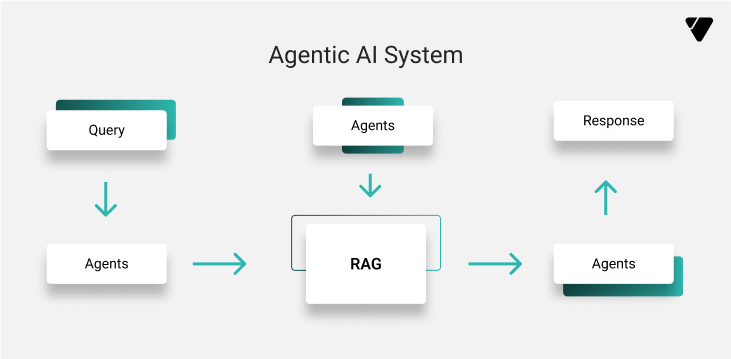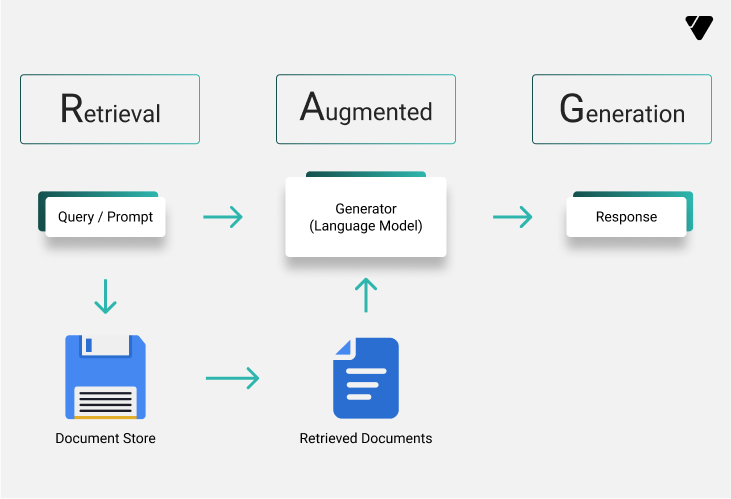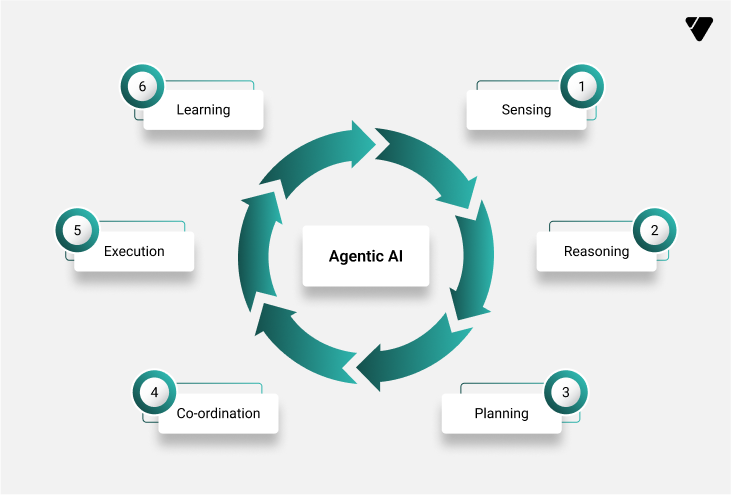As artificial intelligence (AI) continues to advance at breakneck speed, Agentic AI emerges as a paradigm that transcends the boundaries of traditional Generative AI to drive growth and innovation in unprecedented ways. This next generation of AI empowers organizations to move beyond reactive responses and embrace proactive, goal-driven systems capable of navigating complex workflows.
According to a Gartner research, 33% of enterprise software applications will incorporate Agentic AI thus enabling 15% of the daily decision-making processes to be done autonomously. A fair glance at these numbers tells us that Agentic AI fosters a synergy between automation and intelligent decision-making through structured workflows and human-like adaptability.
While generative AI focusses on prompt-based query resolution, Agentic AI emphasizes autonomy, goal-oriented behavior, and dynamic decision-making. These systems are designed to operate independently, adapt to changing conditions, and execute complex workflows with minimal human intervention.
This blog delves into the core features of Agentic AI, such as its ability to plan, reason, and act intelligently— hallmarks of goal-driven AI systems, all while continuously learning from human feedback. We explore its applications across industries — from robotics and autonomous vehicles to healthcare, finance, customer service and enterprise operations, highlighting how Agentic AI solutions enhance efficiency, enable AI task delegation tools, and propel innovation.
1. What is Agentic AI
Until now, Generative AI (GenAI) has been the dominant force in the domain of AI, primarily focusing on delivering responses based on predefined prompts. However, the shift from prompt-based models to intelligent automation has gradually led to a new avatar of AI, one we now recognize as Agentic AI.
Agentic AI takes a more proactive approach, automating decision-making processes and workflows without requiring constant human intervention – characteristics of decision-making agents and AI-powered agents.
The ability of Agentic AI to anticipate needs and adapt to evolving challenges has established it as a cornerstone for future advancements in artificial intelligence. This adaptability ensures that organizations can handle unforeseen challenges with agility, making it invaluable in sectors like transportation, manufacturing, and customer service.
At ValueLabs, our Enterprise OS AiDE® further augments the transformative potential of the technology by enabling seamless workflow optimization. With its ability to adapt, reason, and act independently, AiDE® empowers businesses to tackle complex challenges efficiently, driving innovation and operational excellence.
We will delve deeper into its functioning and applications later in this blog. For now, it will suffice to note that Agentic AI extends automation beyond traditional software by interacting with web interfaces, automating UI actions, and extracting insights from digital environments— capabilities that enhance operational efficiency and user experience through Agentic AI for workflow automation.
In this section, we will explore this shift towards autonomy as the defining aspect of Agentic AI, setting it apart from traditional AI systems.
How Agentic AI became the new Organizational Choice:
The metamorphosis from GenAI to Agentic AI marks a transformative moment across industries and workflows, ushering in a new era of goal-driven AI systems and autonomous intelligent systems that fundamentally change how organizations operate. Agentic AI presents a fresh opportunity for organizations due to its ability to autonomously plan and act in dynamic environments:
a) Autonomy and Proactive Decision-making: Agentic AI operates independently, analyzing real-time data and executing workflows with human-in-the-loop. It can set goals and act autonomously, making it ideal for industries requiring real-time decision-making.
b) Structured Execution with Reduced Errors: Frameworks like AiDE® introduce structured workflows where agents plan, reason, and verify outcomes before execution, reducing errors and enhancing reliability. This sharply contrasts with GenAI’s lack of iterative review and potential for inefficiencies.
c) Integration Capabilities: Agentic AI integrates seamlessly with enterprise systems, automating workflows across multiple tools and platforms. This highlights a significant transition from GenAI, which would typically operate as standalone model with limited interaction capabilities.
d) Adaptability through Continuous Learning: Agentic AI represents a natural evolution from Generative AI, adapting dynamically to changing conditions by learning from real-world interactions. AiDE® leverages a persistent memory system to retain past interactions, enabling long-term strategic execution and seamless adaptability.
e) Scalability across Complex Workflows: Agentic AI excels at managing complex workflows autonomously, making it ideal for optimizing resources and reducing human workload across diverse industries.
Agentic AI vs. Traditional forms of AI:
a) Autonomy vs Reactivity: Agentic AI functions autonomously, initiating actions to achieve specific goals, while Generative AI is reactive, creating outputs based on user prompts.
b) Goal-Oriented vs Task-Oriented: Agentic AI is designed to accomplish broader objectives, whereas Generative AI focuses on isolated tasks like content generation.
c) Dynamic Learning vs Rule-Based Execution: Agentic AI continuously learns from real-world interactions and refines its strategies over time. On the other hand, Generative AI relies on patterns learned during training.
d) Environmental Awareness vs Isolated Output: Agentic AI integrates contextual understanding into its decision-making process, while Generative AI operates within predefined parameters without considering broader implications.
Significance of this Shift:
Unlike traditional AI systems, Agentic AI introduces a paradigm of autonomy, adaptability, and proactive decision-making that fundamentally changes how organizations operate. This autonomy enables businesses to achieve unprecedented levels of efficiency and innovation. Reducing the mundanity of repetitive tasks with Agentic AI allows humans to focus on higher-level supervisory skills, enhancing their ability to oversee and guide complex processes effectively.
This ‘Human + AI’ paradigm not only represents the core of our AI-powered operations at ValueLabs, but also exemplifies the potential of Agentic AI to complement human capabilities rather than replace them. Agentic AI systems, like AiDE®, ensure structured, context-aware workflows where agents plan, reason, and verify outcomes before taking action. This approach not only enhances accuracy and reliability but also avoids the inefficiencies of traditional Agentic AI models, which often suffer from redundant processing and unpredictable errors due to siloed operations.
Thus, the impact of Agentic AI is particularly profound in scenarios requiring dynamic responses—such as healthcare diagnostics and disaster management—where real-time decision-making can save lives, reduce costs, and improve outcomes. For instance, in healthcare, Agentic AI can autonomously diagnose diseases and create personalized treatment plans, leveraging persistent memory systems like AiDE® powered memento system to learn from past interactions and improve decision-making over time.
Similarly, in transportation, it optimizes traffic flow and logistics processes by integrating real-time data and adapting to evolving conditions, show-casing the power of scalable AI agent systems and multi-agent systems in modern enterprise operations.
2. How Does Agentic AI Work?
The advantages mentioned above clearly demonstrate that the secret behind the impactful and dynamic interaction of Agentic AI with its environment lies in its focus on adaptability and proactive execution. Drawing from both our industry expertise and he latest research and developments.

Core Mechanisms of Agentic AI
a) Autonomous Decision-making
Agentic AI systems are designed to operate independently by analyzing real-time data and executing actions aligned with predefined objectives. These agents mimic human decision-making processes by assessing options, weighing potential outcomes, and selecting optimal courses of action. This autonomy is achieved when advanced algorithms that integrate natural language understanding (via LLMs) and contextual reasoning enable the system to act without constant human oversight.
AiDE® enhances this autonomy by introducing structured workflows where agents plan, reason, and verify outcomes before execution. Unlike traditional AI systems that often operate in silos and lack holistic oversight, AiDE® ensures seamless coordination between agents, reducing inefficiencies like redundant processing or unpredictable errors (a key advantage of Agentic AI solutions and enterprise AI agents).
b) Iterative Workflows
Another interesting aspect of Agentic AI is its iterative approach to task execution, a core feature of Agentic AI for workflow automation. Tasks are broken down into smaller subtasks, continuously refined through feedback loops. This iterative process allows the system to adapt dynamically to changing conditions or new information, ensuring robust performance even in unpredictable environments. This reflects an approach that supports scalable AI agent systems and AI task delegation tools.
The Plan-Act model of AiDE® exemplifies this principle by separating planning from execution. The Planning Agent structures tasks, checks dependencies, and determines which agents need activation, while the Act Agent executes these steps efficiently. This structured approach avoids uncontrolled loops of trial and error common in less sophisticated systems, reinforcing the strengths of intelligent agents and AI-powered agents.
c) Multi-Agent Collaboration
Agentic AI often operates as a multi-agent system (MAS), where specialized agents work together toward a common goal. Each agent has distinct capabilities—such as knowledge retrieval, workflow orchestration, or user interaction—and shares information via a centralized memory hub. This architecture ensures scalability and flexibility across diverse applications, including enterprise AI agents and business automation with AI agents.
AiDE® extends this concept with its Web Agent, which interacts with web interfaces to automate UI actions such as extracting text or navigating screen layouts. This capability enables businesses to implement AI-driven workflows in areas like AI agents in customer support or test automation, where traditional software automation falls short.
d) Learning and Adaptation
Continuous learning is central to Agentic AI’s functionality. Using techniques like reinforcement learning and supervised fine-tuning, these systems learn from past interactions to improve future performance. Memory components store historical data and context, allowing agents to refine their strategies over time and adapt to evolving challenges.
AiDE® brings persistent memory to the front with its Memento System that retains past interactions across sessions. Unlike traditional AI systems that reset after each request, AiDE® uses this memory to improve decision-making over time, ensuring adaptive intelligence that evolves with experience rather than repeating past mistakes, another improvement in Agentic AI evolution and enterprise AI agents.
Integration of Retrieval-Augmented Generation (RAG)
Retrieval-Augmented Generation (RAG) is a technique that enhances the capabilities of Agentic AI systems by improving the accuracy and relevance of its outputs. The AiDE® Platform leverages RAG principles within its workflows by ensuring that agents access real-time data for more informed decision-making while maintaining accuracy through structured planning and execution processes.

How RAG Works:
a) Information Retrieval: Before generating responses or decisions, the system retrieves relevant data from external sources such as databases or APIs. This ensures access to up-to-date information.
b) Integration with LLMs: Retrieved data is integrated into the system’s knowledge base, allowing it to generate contextually accurate responses.
c) Reducing Hallucinations: By referencing authoritative sources during response generation, RAG minimizes errors or ‘hallucinations,’ where the AI might otherwise produce incorrect or nonsensical outputs.
d) Cost Efficiency: RAG reduces the need for frequent retraining by dynamically retrieving information rather than relying solely on static training datasets.
Technical Workflow of Agentic AI
The operation of an Agentic AI system typically follows these stages:
- Sensing: Agents gather data from their environment using sensory inputs or APIs.
- Reasoning: The collected data is processed using reasoning algorithms or LLMs to understand context and derive insights.
- Planning: Based on reasoned insights, agents develop goal-oriented plans using advanced planning algorithms.
- Coordination: Agents share their plans via shared memory systems to ensure alignment and collaboration across tasks.
- Execution: Agents act on their plans autonomously while monitoring outcomes in real time.
- Learning: Feedback from actions is analyzed to update individual agent memories and improve future decision-making.
AiDE® contributes with its structured execution model that combines intelligent planning with controlled action steps. Its Web Agent further expands the scope of execution by automating tasks across digital environments like a human user would, bridging the gap between traditional software automation and true agentic intelligence

3. Use-cases and Applications of Agentic AI
In this section, we will explore a few common applications of Agentic AI of through case studies and discuss the ethical considerations associated with its deployment.
Case Studies: Industry Applications
a) Healthcare
Agentic AI is transforming healthcare by automating diagnostics, treatment planning, and patient management. For example, AI agents assist doctors in analyzing medical images for early detection of diseases like cancer. The AiDE® platform enhances this process by leveraging structured workflows to ensure accuracy in diagnostics and treatment recommendations. Corollary to this, it’s persistent memory system retains past patient interactions, enabling personalized care and reducing redundant tests, thus highlighting the efficiency and importance of self-directed AI systems.
Additionally, healthcare agents monitor patient data in real-time, adjusting treatment plans based on new results. This proactive approach minimizes errors and improves outcomes. The Web Agent in AiDE® automates administrative processes such as scheduling and electronic health record (EHR) management, allowing healthcare professionals to dedicate more time to critical patient care thus effectively demonstrating the advantages of Agentic AI and its subsequent role in business automation with AI agents.
b) Finance
In finance, Agentic AI plays a pivotal role in fraud detection and risk management. AI agents analyze vast amounts of transaction data to identify anomalies indicative of fraudulent activities. For instance, the AiDE® platform integrates with financial systems to monitor transactions in real-time, flagging suspicious patterns while maintaining compliance with regulatory standards. The Plan-Act model of AiDE® ensures structured execution in investigating fraud cases, reducing false positives and enhancing efficiency.
Moreover, financial institutions use Agentic AI for predictive analytics to model market behaviors and optimize investment strategies. These systems continuously learn from historical data and adapt to market trends, providing actionable insights that drive better decision-making.
c) Customer Service
Agentic AI has become indispensable in customer service through intelligent chatbots and call center automation. AiDE® exemplifies this by orchestrating workflows that analyze customer sentiment, access order histories, and provide tailored solutions—all in real-time. Unlike traditional systems, AiDE® incorporates a unique Web Agent that interacts with web interfaces to extract relevant information seamlessly, ensuring consistent service quality across channels.
For instance, utility companies can use Agentic AI to proactively contact customers about high bills or service disruptions. By offering personalized solutions based on individual usage patterns, these systems enhance customer satisfaction while reducing operational costs.
d) Supply Chain Management
Showcasing both scalable AI agent systems and multi-agent systems in action, Agentic AI optimizes supply chain operations by analyzing logistics data to predict demand and streamline inventory management. The AiDE® platform automates complex workflows such as reordering supplies from alternative vendors during shortages or adjusting production schedules based on delivery timelines. The persistent memory system of AiDE® ensures continuity across sessions, enabling long-term strategic planning.
In situations of natural calamities, like hurricanes or wildfires, Agentic AI helps utilities assess infrastructure damage, prioritize repairs and route resources efficiently—saving lives and accelerating recovery times and highlighting the future of AI agents in critical infrastructure management.
The above 4 points succinctly demonstrate the plethora of Agentic AI use cases depending on the industry and enterprise size. That being said, the objective of identifying use-cases and applications is to make the best of Agentic AI offerings. This also requires a careful consideration of the following ethical concerns:
Ethical Considerations:
While Agentic AI offers immense benefits, its deployment raises critical ethical concerns:
a) Privacy: The ability of Agentic AI to access sensitive data, such as medical records or financial transactions, proposes risks related to privacy breaches. We ensure to implement robust encryption protocols and adhere to strict regulatory frameworks like GDPR to protect user data.
b) Bias: AI systems can inherit biases from training datasets or algorithms, leading to discriminatory outcomes in areas like hiring or loan approvals. We address this challenge by incorporating bias-detection mechanisms within AiDE® augmented workflows to ensure fairness and inclusiveness.
c) Accountability: The autonomous nature of Agentic AI complicates accountability for decisions made by the system. For example, if an AI agent makes an incorrect diagnosis or flags a false fraud alert, determining responsibility can be challenging. To address this issue, our engineers establish clear guidelines for human oversight and control points to mitigate risks when deploying autonomous intelligent systems.
d) Transparency: Agentic AI systems must provide explainable outputs to ensure trust among users and stakeholders. Our digital engineering platform, AiDE® incorporates structured workflows that allow users to trace decisions back to their source logic or data inputs- supporting intentionality in AI and transparency in enterprise AI agents.
4. How ValueLabs Embraces the Agentic AI Evolution
At ValueLabs, we are proud to be championing the Agentic AI revolution through our proprietary AiDE® platform, redefining automation, intelligence, and digital engineering. AiDE® serves as the cornerstone of our approach, seamlessly integrating AI agents across enterprise functions to ensure dynamic and cohesive workflows. Its ability to plan, reason, and verify outcomes before execution significantly enhances reliability and sets a new standard for accuracy in AI-driven processes.
Launched in 2022 as an AI-powered IDE, AiDE® began to enhance coding and testing. By the end of the year it became fairly evident that AiDE® was meant transform the entire software development process, evolving into AI Driven Engineering. Inspired by the rapid advancements in AI technology, AiDE® expanded to redefine enterprise workflows, becoming AI Driven Everything.
Our commitment to innovation extends beyond functionality. Through persistent memory systems like Memento, AiDE® evolves intelligently by retaining past interactions and improving decision-making over time. This adaptability ensures long-term strategic execution in rapidly changing environments. Moreover, ethical considerations remain central to our design philosophy, with bias-detection mechanisms and transparent operations fostering trust among stakeholders.
From software development to quality engineering and IT support, AiDE® empowers organizations across diverse industries by reducing costs, enhancing speed, and improving quality.
What started as an AI-powered IDE, built to accelerate how developers code and test, has now become so ingrained into our Enterprise OS that it powers every layer of The ValueLabs Stack.
Its customizable LLMs trained on industry-specific datasets ensure tailored solutions that address unique challenges. AiDE® has won global AI awards and transformed how thousands of people work every day, across hundreds of enterprise clients.
Conclusion
As we continue to explore the potential of Agentic AI, ValueLabs remains committed to delivering solutions that empower businesses to navigate digital complexities confidently.
With AiDE® now serving as our enterprise OS, we integrate security, reliability, and innovation into every facet, allowing us to operate on an Agentic level and set new benchmarks for AI capabilities, solidifying our position in the evolving landscape of generative AI.
Contact us to see how AiDE® can drive your business forward.